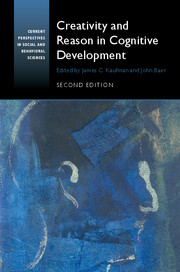Book contents
- Frontmatter
- Dedication
- Contents
- List of Contributors
- Acknowledgments
- 1 Creativity, Reason and Cognitive Development: Ten Years Later
- SECTION ONE CREATIVITY AND REASON IN CHILDHOOD AND THE SCHOOLS
- 2 Creativity in Young Children's Thought
- 3 Early Experiences and Creativity: An Ecological Perspective
- 4 Imaginative Play
- 5 Revisiting the Relationship among Schooling, Learning, and Creativity
- 6 Higher Level Thinking in Gifted Education
- 7 A Young Artist's Story: Advancing Knowledge and the Development of Artistic Talent and Creativity in Children
- SECTION TWO CREATIVITY AND REASON IN COGNITION AND NEUROSCIENCE
- SECTION THREE CREATIVITY AND REASON: INTERACTIONS AND RELATED CONSTRUCTS
- Author Index
- Subject Index
- References
3 - Early Experiences and Creativity: An Ecological Perspective
from SECTION ONE - CREATIVITY AND REASON IN CHILDHOOD AND THE SCHOOLS
Published online by Cambridge University Press: 05 February 2016
- Frontmatter
- Dedication
- Contents
- List of Contributors
- Acknowledgments
- 1 Creativity, Reason and Cognitive Development: Ten Years Later
- SECTION ONE CREATIVITY AND REASON IN CHILDHOOD AND THE SCHOOLS
- 2 Creativity in Young Children's Thought
- 3 Early Experiences and Creativity: An Ecological Perspective
- 4 Imaginative Play
- 5 Revisiting the Relationship among Schooling, Learning, and Creativity
- 6 Higher Level Thinking in Gifted Education
- 7 A Young Artist's Story: Advancing Knowledge and the Development of Artistic Talent and Creativity in Children
- SECTION TWO CREATIVITY AND REASON IN COGNITION AND NEUROSCIENCE
- SECTION THREE CREATIVITY AND REASON: INTERACTIONS AND RELATED CONSTRUCTS
- Author Index
- Subject Index
- References
Summary
Diane's art studio is located at the center of a school building that houses a diverse population of children from four years old through eighth grade. The studio is physically and philosophically central to the work that takes place in the building yet intentionally designed as a space apart. When Diane meets with children before their first visit to the studio, she starts the process of defining what is different there and what is possible there and welcomes them into a context and culture that nurtures, honors, and supports the creative process. From that point forward, each time children approach the door to the studio, she quietly asks them to pause and think about this question: Are you ready to be artists? This moment of focus marks the physical and psychological boundary between this space and many others in a child's life.
The space communicates this clearly to children. Materials and tools are arranged to stimulate eyes and mind and are accessible to the children. “Is all this stuff for kids to use?” some will ask. Yes, children's planning, doing and meaning-making happen here.
Shelves with work-in-progress are clearly visible. Thinking and doing are not time bound by class periods. Children have time for finding and re-finding the intention of their work and defining and redefining problems encountered as Diane introduces new information, new strategies and new ways of thinking. Children critique their work against their initial intentions and practice decision making as they determine when a piece of work is complete.
“Is there really a rabbit in here?” Claude Monet, the studio rabbit, does indeed live here and moves around the studio freely while the children work. He plays a critical role in creating and maintaining a climate of calm and focus and where all children, all work, and a rabbit are respected and safe.
Each time children enter the studio, knowledge about themselves and their worlds and flexible, generative, and critical thinking not only coexist but also thrive and grow here. “This place is different.”
As we consider the development of creativity and the acquisition of knowledge and analytic skills in early childhood we do so from an ecological perspective. Simply put, context matters. A child develops within interacting environmental systems made up of particular individuals and communities within institutions and overarching societal norms.
- Type
- Chapter
- Information
- Creativity and Reason in Cognitive Development , pp. 33 - 51Publisher: Cambridge University PressPrint publication year: 2016



